Gardenia: care, reproduction, transplantation
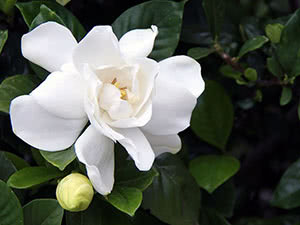 Gardenia is a genus of the family Rubiaceae from the tropics, named after the American physician and naturalist Alexander Garden. In room conditions gardenia flowers do not take up much space, but in its natural habitat, and it grows in East and South-East Asia and South Africa, gardenia plants can be up to 2 m (7 ft) high. Gardenia jasminoides is the most popular species for home; it’s also called cape jessamine or cape jasmine and was firstly brought to England in 1760.
Gardenia is a genus of the family Rubiaceae from the tropics, named after the American physician and naturalist Alexander Garden. In room conditions gardenia flowers do not take up much space, but in its natural habitat, and it grows in East and South-East Asia and South Africa, gardenia plants can be up to 2 m (7 ft) high. Gardenia jasminoides is the most popular species for home; it’s also called cape jessamine or cape jasmine and was firstly brought to England in 1760.
Florists grow it not only for its beautiful white wax-like and subtlety smelling of jasmine flowers, but also for its shiny leaves of rich dark green color, that are a worthy decoration of gardenia even when it is not in bloom.
Home gardenia: cultivation features
Gardenia jasminoides is an evergreen bush that grows up to 45-55 cm (18-22 in) high. Its shoots can be both naked and downy. The leaves of the gardenia plant are dark-green, bright and shiny, as if covered in wax, and about 10 cm (4 in) long. They are also shortly petiolar, wide lanceolate or reverse obovoid and narrower to the base. Gardenia blossoms in summer with odorous singular or few-flowered (4 to 6 each) corymbose inflorescence. In the beginning of blossoming the flowers are foam white but later they turn yellower. The size of the flowers is up to 8 cm (3 in) wide and most of the cultivated gardenia flowers are polypetalous. Gardenia care at home is not as easy as, for example, pelargonium, but the end justifies the means. So, here are some valuable tips for your own gardenia bush:
- gardenia does not tolerate either extra dry soil or stagnant water;
- soil acidity means a lot to gardenia therefore you’d better test it before you plant it; the level has to be less than 5.5 pH;
- air temperature must always be in the range of 16-24 ºC (60-75 ºF);
- remove withered buds immediately.
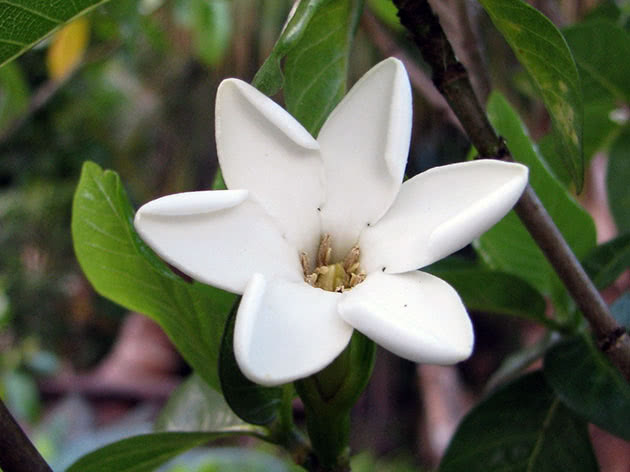
Home gardenia care
How to take care of gardenia at home
Find a bright, warm, protected from drafts place in the apartment: the lighting should be bright but scattered, the temperature, as was said before, must be between 16 and 24 ºC (60-75 ºF). The flower would like the eastern or western windowsills best, northern has to be excluded and southern ones need to be shady from direct sunlight from 11 am till 5 pm. In winter you would have to light it additionally with fluorescent lamps because winter’s day length is too short for gardenia plants. But even if the location is chosen well and you take proper care of the plant, it still may take a long time for it to settle down and get used to new conditions. It still may act capriciously and even lose its buds.

Watering gardenia
One of the most important points of how to take care of gardenia is watering. Watering has to be frequent, especially in the periods of active growth (spring and summer), taking into account the level of drying of the upper soil layer. Autumn and winter watering is much less frequent or abundant, wait out for 2-3 days after the soil surface gets dry. Once a month pour some acidified water in the pot, other times use softer water, preferably boiled or filtered. It also has to be of room temperature.
Air humidity has to be high, especially during budding period, thus put the flower on the tray with damp moss, claydite or pebbles in a way that will not let the pot’s bottom touch the water. Spray gardenia with warm water frequently until the buds start to open. If an open flower gets some water on it, it may lead to appearance of brown spots. Instead of spraying, wipe the leaves of gardenia with a damp cloth. Try not to move or even turn the pot, because that may make the flower dump its buds.
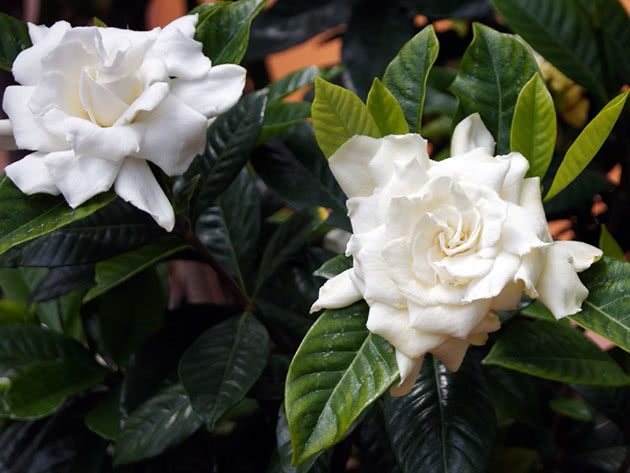
Fertilizing of gardenia
Dosing of a young gardenia is done bimonthly with both mineral and organic fertilizers, alternately. An adult plant needs dosing every week during the whole vegetation period, but do not use fertilizers that contain calcium. Liquid fertilizers are preferable; do not forget to read the instructions before application. Peat humic fertilizers benefit gardenias, liquid potassium fertilizer for houseplants also does not cause reclamations, but be sure to decrease the recommended by the manufacturer dose in half. For pH normalization you need to use iron supplements twice during vegetation. There is no need for dosing during winter.
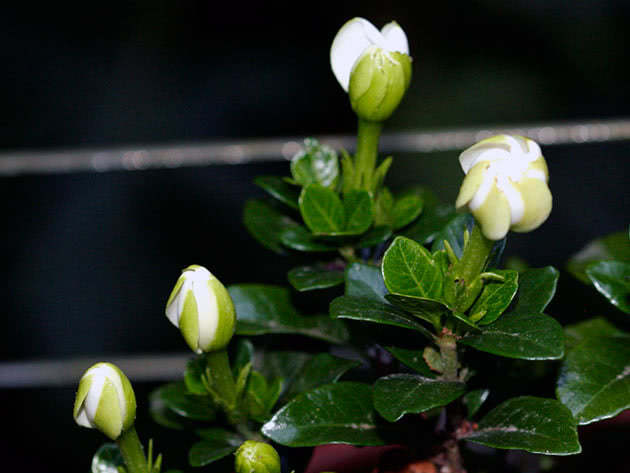
Gardenia transplanting
Soil used for gardenia plants has to consist of sand, turf, coniferous, peat and leaf soils in equal parts. A proper drainage layer is mandatory, acidity level was mentioned before. If you cannot make your own soil mixture, you may use soil for azaleas. Gardenia transplant should be done in early spring or, in case of necessity, after flowering. For young plants such necessity exists once a year, for older ones once in three years. If you have only purchased this plant, there is no need for an immediate transplant, wait out for a few weeks. If you bought the plant in bloom, wait until blooming ends before you go through with the transplant. In order to spare this whimsical plant extra trouble, put it in a new pot with drainage and add necessary amount of soil.
Gardenia reproduction at home
Gardenia grown from seeds
Growing gardenia out of a seed is not the best way to go if you want to multiply it. Only freshly gathered seeds are suitable for reproduction, and even those lose germination very quickly. Before you put the seeds into soil for azaleas, they need to be kept for 2-3 hours in zircon or aloe juice. After that is done, cover the seeds with 0.5 cm (0.2 in) of the same soil, (let it go through a sieve), water it carefully, cover the container with film or glass, and keep it warm, airing it out from time to time for an hour or two. Sprouts will appear not sooner than in a month. If they appear in wintertime, you might need to light them additionally.
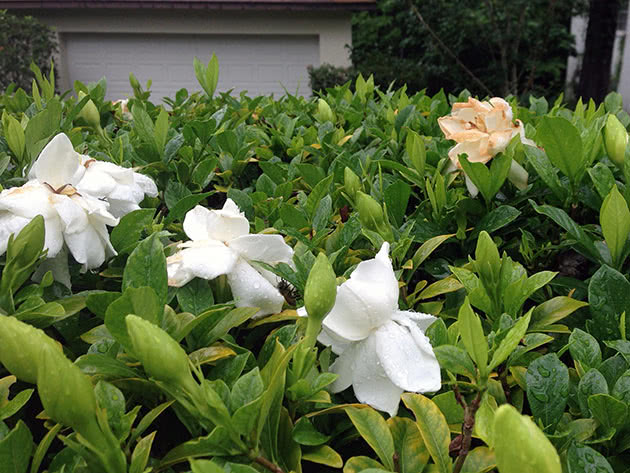
Gardenia grown from cutting
After gardenia sheds its blossoms, one should cut its shoots by two-thirds of its lengths, removing weak ones and thinning it out if the bush became too thick. Occasional nipping is also required even during growing period, for tillering purposes. These apical or half-wooden cuts are the main source of gardenia reproduction. Shoot’s length has to be about 10 cm (4 in), its substrate should consist in halves from sand and peat. Keep the cuts in light pink manganese solution for half an hour before you put them in soil and cover with film or glass to create greenhouse effect. The temperature should be 25 ºC (77 ºF), frequent ventilation and watering is expected. You might speed up rooting with additional heating of the bottom of the container. After the cuts take roots, they should be transplanted into soil for azaleas or grown-up gardenias. When they reach the height of 15 cm (6 in), nip them to stimulate the emergence of side shoots. When those side shoots reach height of 10-12 cm (3-4 in), nip them too. After a new plant becomes more bush-like, transplant it into a bigger pot.
Gardenia diseases
Gardenia loses its buds
Sometimes this issue is laid back in the time of formation of buds due to temperature regime disturbance. Always ensure that the temperature is kept within 18-20 ºC (65-68 ºF) during the day and 16-18 ºC (61-65 ºF) at night. If the night temperature is too high, the buds may not even be formed. And there should not be any sudden changes! Watering ought to be regular. Lack of humidity or improper lighting, drafts and moving the flowerpot from place to place can all lead to the loss of buds. Therefore, be vigilant and disciplined.
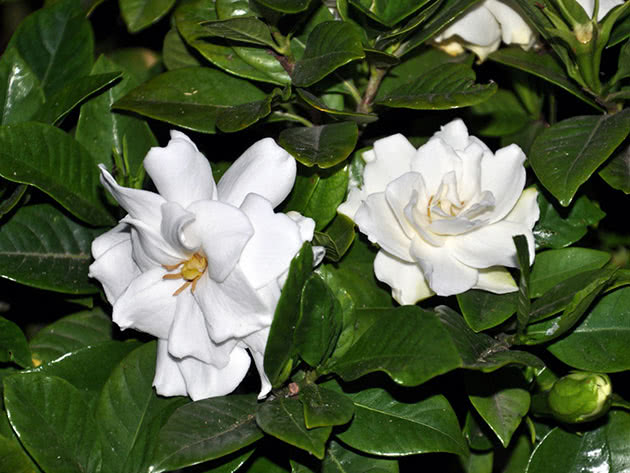
Gardenia black leaves
The simplest explanation for the fact that gardenia leaves turn black, is in the wrong watering. Either soil is too dry, or it was too wet for a long time, which may result in gardenia leaves turning black and falling off. Reread the rules of caring for the flower to understand why your gardenia blackens, eliminate deficiencies, create the most comfortable conditions for the plant, dose it with iron supplements and cover it with spacious transparent plastic bag to achieve absolute humidity. Water the plant, when the upper layer of the substrate becomes dry.

Gardenia yellow leaves
If gardenia leaves turn yellow, especially lower ones, it’s a sign of soil overwetting. Decrease watering, remove the plant from the tray with damp rocks, and, mainly, eliminate the drafts! If the upper leaves are getting yellow, this may mean there’s an excess of lime and chlorine in the soil. Immediately transplant gardenia into new ground and eliminate the fertilizer, which contains lime. Water the plant only with rainwater, purified or boiled water above room temperature. Sometimes gardenia leaves turn yellow because of a lack of nitrogen in the soil, or due to poor lighting.

Gardenia leaves fall off
Leaf fall is a direct consequence of their blackening or yellowing, so the sooner you find out the reason why the leaves turn black or yellow, the less leaves the plant will lose. In any case, the main cause of diseases gardenia gets is violation of agro-technical requirements of caring. Correct your mistakes in time, save your gardenia, and it will decorate your home with incredibly beautiful and fragrant flowers.
